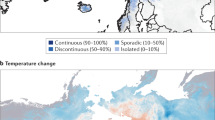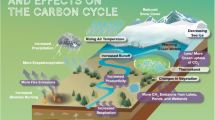Abstract
Releases of the greenhouse gases carbon dioxide (CO2) and methane (CH4) from thawing permafrost are expected to be among the largest feedbacks to climate from arctic ecosystems. However, the current net carbon (C) balance of terrestrial arctic ecosystems is unknown. Recent studies suggest that these ecosystems are sources, sinks, or approximately in balance at present. This uncertainty arises because there are few long-term continuous measurements of arctic tundra CO2 fluxes over the full annual cycle. Here, we describe a pattern of CO2 loss based on the longest continuous record of direct measurements of CO2 fluxes in the Alaskan Arctic, from two representative tundra ecosystems, wet sedge and heath tundra. We also report on a shorter time series of continuous measurements from a third ecosystem, tussock tundra. The amount of CO2 loss from both heath and wet sedge ecosystems was related to the timing of freeze-up of the soil active layer in the fall. Wet sedge tundra lost the most CO2 during the anomalously warm autumn periods of September–December 2013–2015, with CH4 emissions contributing little to the overall C budget. Losses of C translated to approximately 4.1 and 1.4% of the total soil C stocks in active layer of the wet sedge and heath tundra, respectively, from 2008 to 2015. Increases in air temperature and soil temperatures at all depths may trigger a new trajectory of CO2 release, which will be a significant feedback to further warming if it is representative of larger areas of the Arctic.








Similar content being viewed by others
References
Amiro BD et al. 2010. Ecosystem carbon dioxide fluxes after disturbance in forests of North America. J Geophys Res 115 (G4). doi:10.1029/2010JG001390.
Baldocchi D. 2014. Measuring fluxes of trace gases and energy between ecosystems and the atmosphere- the state and future of the eddy covariance method. Global Change Biol 20:3600–9.
Belshe EF, Schuur EAG, Bolker BM. 2013. Tundra ecosystems observed to be CO2 sources due to differential amplification of the carbon cycle. Ecol Lett 16(10):1307–15.
Björkman MP et al. 2010. Winter carbon dioxide effluxes from Arctic ecosystems: an overview and comparison of methodologies. Global Biogeochem Cycles 24(GB3010):1–10.
Burba GG et al. 2008. Addressing the influence of instrument surface heat exchange on the measurements of CO2 flux from open-path gas analyzers. Global Change Biol 14:1854–76.
Burba GG, Anderson DA. 2010. Brief Practical Guide to Eddy Covariance Flux Measurements: Principles and Workflow Examples for Scientific and Industrial Applications. Lincoln, NE: LI-COR.
Chang Y-W et al. 2104. Methane emissions from Alaska in 2012 from CARVE airborne observations. Proc Natl Acad Sci USA 111:16694–9.
Christensen TR. 2014. Understand Arctic methane variability. Nature 509:279–81.
Coyne PI, Kelley JJ. 1971. Release of carbon dioxide from frozen soil to the Arctic atmosphere. Nature 234:407–8.
Dlugokencky E et al. 2009. Observational constraints on recent increases in the atmospheric CH4 burden. Geophys Res Lett 36:L18803.
Drotz SH, Sparrman T, Nilsson MB, Schleucher J, Öquist MG. 2010. Both catabolic and anabolic heterotropic microbial activity proceed in frozen soils. Proc Natl Acad Sci USA 107:21046–51.
Duarte CM, Lenton TM, Wadhams P, Wassman P. 2012. Abrupt climate change in the Arctic. Nat Clim Change 2:60–2.
Efron B, Tibshirani R. 1998. An Introduction to the Bootstrap. Boca Raton: Chapman and Hall.
Euskirchen ES, Bret-Harte MS, Scott GJ, Edgar C, Shaver GR. 2012. Seasonal patterns of carbon dioxide and water fluxes in three representative tundra ecosystems in northern Alaska. Ecosphere 3:1–19.
Falge E et al. 2001. Gap filling strategies for defensible annual sums of net ecosystem exchange. Agric Forest Meteorol 107:43–69.
Fisher JB et al. 2014. Carbon cycle uncertainty in the Alaskan Arctic. Biogeosciences 11:4271–88.
Fratini G, Mauder M. 2014. Towards a consistent eddy covariance processing: an intercomparison of EddyPro and TK3. Atmos Meas Tech 7:2263–3381.
Hicks Pries CE, Schuur EAG, Crummer KG. 2013. Thawing permafrost increases old soil and autotrophic respiration in tundra: Partitioning ecosystem respiration using δ13C and Δ14C. Global Change Biol 19:649–61.
Hinzman LD, Kane DL, Gieck RE, Everett KR. 1991. Hydrologic and thermal properties of the active layer in the Alaskan Arctic. Cold Reg Sci Technol 19:95–110.
Hugelius G et al. 2014. Estimated stocks of circumpolar permafrost carbon with quantified uncertainty ranges and identified data gaps. Biogeosciences 11:6573–93.
Jeffries MO, Overland JE, Perovich DK. 2013. The Arctic shifts to a new normal. Phys Today 66:35–40.
Jorgenson MT, Heiner M. 2004. Ecosystems of Northern Alaska. ABR, Inc. and The Nature Conservancy, Anchorage, AK.
Kade A, Bret-Harte MS, Euskirchen ES, Edgar C, Fulweber R. 2012. Seasonal variations in CO2 flux among various tundra plant communities in Arctic Alaska. J Geophys Res 117:1–11.
Karhu K et al. 2014. Temperature sensitivity of soil respiration rates enhanced by microbial community response. Nature 513:81–4.
Inc LI-COR. 2004. LI-7500 CO2/H2O Analyzer Instruction Manual. Lincoln, NE: LI-COR.
Inc LI-COR. 2009. LI-7500A Open-path CO2/H2O Open Path Gas Analyzer Instruction Manual. Lincoln, NE: LI-COR.
Inc LI-COR. 2010a. LI-7200 CO2/H2O Analyzer Instruction Manual. Lincoln, NE: LI-COR.
Inc LI-COR. 2010b. LI-7700 Open Path CH4 Analyzer Instruction Manual. Lincoln, NE: LI-COR.
LI-COR Inc. 2013. EddyPro® 4.2 Help and User’s Guide. (LI-COR, Inc. Lincoln, Nebraska).
Lüers J, Westermann S, Piel K, Boike J. 2014. Annual CO2 budget and seasonal CO2 exchange signals at a high Arctic permafrost site on Spitsbergen, Svalbard archipelago. Biogeosciences 11:6307–22.
Massman WJ. 2000. A simple method for estimating frequency response corrections for eddy covariance systems. Agric Forest Meteorol 104(3):185–98.
Massman WJ. 2001. Reply to comment by Rannik on “A simple method for estimating frequency response corrections for eddy covariance systems”. Agric Forest Meteorol 107:247–51.
McGuire AD et al. 2009. Sensitivity of the carbon cycle in the Arctic to climate change. Ecol Monogr 79:523–55.
McGuire AD et al. 2012. An assessment of the carbon balance of the Arctic tundra: comparisons among observations, process models, and atmospheric inversions. Biogeosciences 9:3185–204.
Mueller CW et al. 2015. Large amounts of labile organic carbon in permafrost soils of Northern Alaska. Global Change Biol 21:2804–17.
Myers-Smith IH. 2015. Climate sensitivity of shrub growth across the tundra biome. Nat Clim Change 5:887–91.
Myhre GD et al. 2013. Anthropogenic and Natural Radiative Forcing. In: Climate Change 2013: The Physical Science Basis. Contribution of Working Group I to the Fifth Assessment Report of the Intergovernmental Panel on Climate Change [Stocker TF, and others (eds.)]. Cambridge University Press, Cambridge, United Kingdom and New York.
Natali SM, Schuur EAG, Rubin RL. 2012. Increased plant productivity in Alaskan tundra as a result of experimental warming of soil and permafrost. J Ecol 100:488–98.
Nauta AL et al. 2015. Permafrost collapse after shrub removal shifts tundra ecosystems to a methane source. Nat Clim Change 5:67–70.
O’Conner FM et al. 2010. Possible role of wetlands, permafrost, and methane hydrates in the methane cycle under future climate change: a review. Rev Geophys 48(RG4005):1–33. doi:10.1029/2010RG000326.
Oechel WC, Laskowski CA, Burba G, Gioli B, Kalhori AAM. 2014. Annual patterns and budget of CO2 flux in an Arctic tussock tundra ecosystem. J Geophys Res Biogeosci 119:323–39. doi:10.1002/2013JG002431.
Osterkamp TE. 2005. The recent warming of permafrost in Alaska. Global Planet Change 49:187–202.
Osterkamp TE, Jorgenson JC. 2006. Warming permafrost in the Arctic National Wildlife Refuge, Alaska. Permafr Periglac Process 17:65–9.
Overland JE, Wang M, Walsh JE, Stroeve JC. 2013. Future Arctic climate changes: adaptation and mitigation time scales. Earth’s Future 2:68–74.
Panikov NS, Flanagan PW, Oechel WC, Matepanov MA, Christensen TR. 2006. Microbial activity in soils frozen to below −39°C. Soil Biol Biogeochem 38:785–94.
Papale D et al. 2006. Towards a standardized processing of net ecosystem exchange measured with eddy covariance technique: Algorithms and uncertainty estimation. Biogeosciences 3:571–83.
Parmentier F-JW et al. 2013. The impact of lower sea-ice extent on Arctic greenhouse-gas exchange. Nat Clim Change 3:195–202.
Reichstein M et al. 2005. On the separation of net ecosystem exchange into assimilation and ecosystem respiration: Review and improved algorithm. Global Change Biol 11:1424–39.
Romanovsky VE, Sergueev DO, Osterkamp TE. 2003. Temporal variations in the active layer and near-surface permafrost temperatures at the long-term observatories in Northern Alaska. In: Phillips M, Springman S, Arenson LU, Eds. Permafrost. Lisse: Swets & Zeitlinger. p 989–94.
Romanovsky VE, Smith SL, Christiansen HH. 2010. Permafrost thermal state in the polar Northern Hemisphere during the international polar year 2007-2009: a synthesis. Permafr Periglac Process 21:106–16.
Schuur EAG et al. 2015. Climate change and the permafrost carbon feedback. Nature 520:171–9.
Sen PK. 1968. Estimates of the regression coefficient based on Kendall’s Tau. J Am Stat Assoc 63:1379–89.
Shaver GR, Chapin FSIII. 1991. Production: biomass relationships and element cycling in contrasting arctic vegetation. Ecol Monogr 61(1):1–31.
Sistla SA et al. 2013. Long-term warming restructures Arctic tundra without changing net carbon storage. Nature 497:615–18.
Ueyama M et al. 2013. Seasonal and spatial variations of carbon fluxes of arctic and boreal ecosystems in Alaska. Ecol Appl 23:1798–816.
von Fischer JC, Rhew RC, Ames GM, Fosdick BK, von Fischer PE. 2010. Vegetation height and other controls of spatial variability in methane emissions from the Arctic coastal tundra at Barrow. Alaska. J Geophys Res 115. doi:10.1029/2009JG001283.
Webb EE et al. 2016. Increased wintertime CO2 loss as a result of sustained tundra warming. J Geophys Res 121. doi:10.1002/2014JG002795.
Webb EK, Pearman GI, Leuning R. 1980. Correction of flux measurements for density effects due to heat and water vapour transfer. Q J R Meteorol Soc 106:85–100.
Yue S, Pilon P, Phinney B, Cavadias G. 2002. The influence of autocorrelation on the abilityto detect trend in hydrological series. Hydrol Process 16:1807–29.
Zona D et al. 2016. Cold season emissions dominate the Arctic tundra methane budget. Proc Natl Acad Sci USA 113:40–5.
Acknowledgements
This work was funded by the National Science Foundation Division of Polar Programs Arctic Observatory Network Grant Numbers 856864, 1304271, 0632264, and 1107892. This study was also partially funded by the NSF Alaska Experimental Program to Stimulate Competitive Research award number OIA-1208927. Logistical support was provided by CH2M Hill Polar Services. We thank Diane Huebner, Jackson Drew, and Lola Oliver for assistance with soil C samples. F.S. Chapin III, S.C. Wofsy, and two anonymous reviewers provided valuable comments on an earlier draft of this manuscript.
Author information
Authors and Affiliations
Corresponding author
Additional information
Author Contributions
E.S.E, M.S.B.H., and G.R.S. conceived the micrometeorological study and scientific objectives. V.E.R. designed and installed the borehole temperature measurements and analyzed the data. E.S.E. and C.W.E. processed and analyzed the micrometeorological data. M.S.B.H. and C.W.E. collected, processed, and analyzed the soil C data. All authors commented on the analysis and presentation of the data. E.S.E wrote the paper with contributions from all authors.
Data for our project can be found on our project webpage at: http://aon.iab.uaf.edu/
Electronic Supplementary Material
Below is the link to the electronic supplementary material.
Rights and permissions
About this article
Cite this article
Euskirchen, E.S., Bret-Harte, M.S., Shaver, G.R. et al. Long-Term Release of Carbon Dioxide from Arctic Tundra Ecosystems in Alaska. Ecosystems 20, 960–974 (2017). https://doi.org/10.1007/s10021-016-0085-9
Received:
Accepted:
Published:
Issue Date:
DOI: https://doi.org/10.1007/s10021-016-0085-9




